Related Research Articles
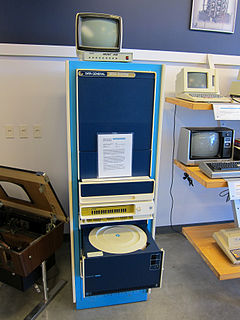
The Data General Nova is a series of 16-bit minicomputers released by the American company Data General. The Nova family was very popular in the 1970s and ultimately sold tens of thousands of units.
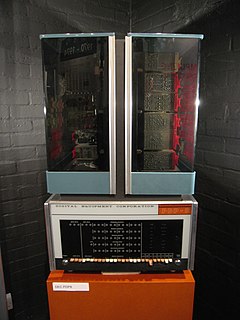
The PDP-8 is a 12-bit minicomputer that was produced by Digital Equipment Corporation (DEC). It was the first commercially successful minicomputer, with over 50,000 units being sold over the model's lifetime. Its basic design follows the pioneering LINC but has a smaller instruction set, which is an expanded version of the PDP-5 instruction set. Similar machines from DEC are the PDP-12 which is a modernized version of the PDP-8 and LINC concepts, and the PDP-14 industrial controller system.

The PDP-11 is a series of 16-bit minicomputers sold by Digital Equipment Corporation (DEC) from 1970 into the 1990s, one of a set of products in the Programmed Data Processor (PDP) series. In total, around 600,000 PDP-11s of all models were sold, making it one of DEC's most successful product lines. The PDP-11 is considered by some experts to be the most popular minicomputer.

RSX-11 is a discontinued family of multi-user real-time operating systems for PDP-11 computers created by Digital Equipment Corporation. In widespread use through the late 1970s and early 1980s, RSX-11 was influential in the development of later operating systems such as VMS and Windows NT.
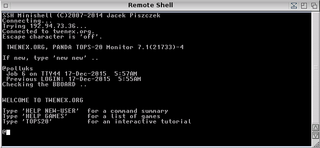
The TOPS-20 operating system by Digital Equipment Corporation (DEC) was a proprietary OS used on some of DEC's 36-bit mainframe computers. The Hardware Reference Manual was described as for "DECsystem-10/DECSYSTEM-20 Processor".
RT-11 is a discontinued small, low-end, single-user real-time operating system for the Digital Equipment Corporation PDP-11 family of 16-bit computers. RT-11, which stands for Real-Time, was first implemented in 1970 and was widely used for real-time systems, process control, and data acquisition across the full line of PDP-11 computers. It was also used for low-cost general-use computing.
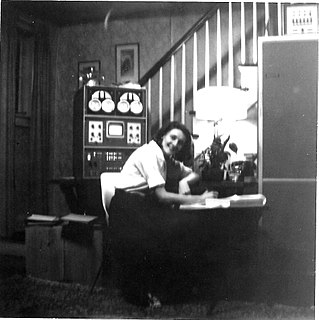
The LINC is a 12-bit, 2048-word transistorized computer. The LINC is considered by some the first minicomputer and a forerunner to the personal computer. Originally named the "Linc", suggesting the project's origins at MIT's Lincoln Laboratory, it was renamed LINC after the project moved from the Lincoln Laboratory. The LINC was designed by Wesley A. Clark and Charles Molnar.
OS/8 was the primary operating system used on the Digital Equipment Corporation's PDP-8 minicomputer.
Peripheral Interchange Program (PIP) was a utility to transfer files on and between devices on Digital Equipment Corporation's computers. It was first implemented on the PDP-6 architecture by Harrison "Dit" Morse early in the 1960s. It was subsequently implemented for DEC's operating systems for PDP-10, PDP-11, and PDP-8 architectures. In the 1970s and 1980s Digital Research implemented PIP on CP/M and MP/M.
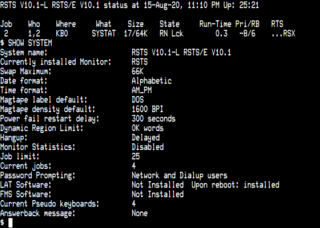
RSTS is a multi-user time-sharing operating system, initially developed by Evans Griffiths & Hart of Boston, and acquired by Digital Equipment Corporation for the PDP-11 series of 16-bit minicomputers. The first version of RSTS was implemented in 1970 by DEC software engineers that developed the TSS-8 time-sharing operating system for the PDP-8. The last version of RSTS was released in September 1992. RSTS-11 and RSTS/E are usually referred to just as "RSTS" and this article will generally use the shorter form.
VSI BASIC for OpenVMS is the latest name for a dialect of the BASIC programming language created by Digital Equipment Corporation (DEC) and now owned by VMS Software Incorporated (VSI). It was originally developed as BASIC-PLUS in the 1970s for the RSTS-11 operating system on the PDP-11 minicomputer. It was later ported to OpenVMS, first on VAX, then Alpha, and most recently Integrity.

The PDP-15 was the fifth and last of the 18-bit minicomputers produced by Digital Equipment Corporation. The PDP-1 was first delivered in December 1959 and the first PDP-15 was delivered in February 1970. More than 400 of these successors to the PDP-9 were ordered within the first eight months.

The Professional 325 (PRO-325), Professional 350 (PRO-350), and Professional 380 (PRO-380) were PDP-11 compatible microcomputers introduced in 1982 by Digital Equipment Corporation (DEC) as high-end competitors to the IBM PC.
MACRO-11 is an assembly language with macro facilities for PDP-11 minicomputers from Digital Equipment Corporation (DEC). It is the successor to PAL-11, an earlier version of the PDP-11 assembly language without macro facilities.

A front panel was used on early electronic computers to display and allow the alteration of the state of the machine's internal registers and memory. The front panel usually consisted of arrays of indicator lamps, digit and symbol displays, toggle switches, dials, and push buttons mounted on a sheet metal face plate. In early machines, CRTs might also be present. Prior to the development of CRT system consoles, many computers such as the IBM 1620 had console typewriters.
BATCH-11/DOS-11, also known simply as DOS-11, is a discontinued operating system by Digital Equipment Corporation (DEC) of Maynard, Massachusetts. The first version of DOS-11 (V08-02) was released in 1970 and was the first operating system to run on the Digital PDP-11 minicomputer. DOS-11 was not known to be easy to use even in its day and became much less used in 1973 with the release of the RT-11 operating system.

LINC-8 was the name of a minicomputer manufactured by Digital Equipment Corporation between 1966 and 1969. It combined a LINC computer with a PDP-8 in one cabinet, thus being able to run programs written for either of the two architectures.

The Intersil 6100 is a single-chip microprocessor implementation of the 12-bit PDP-8 instruction set, along with a range of peripheral support and memory ICs developed by Intersil in the mid-1970s. It was sometimes referred to as the CMOS-PDP8. Since it was also produced by Harris Corporation, it was also known as the Harris HM-6100. The Intersil 6100 was introduced in the second quarter of 1975, and the Harris version in 1976.
The PDP-11 architecture is a CISC instruction set architecture (ISA) developed by Digital Equipment Corporation (DEC). It is implemented by central processing units (CPUs) and microprocessors used in PDP-11 minicomputers. It was in wide use during the 1970s, but was eventually overshadowed by the more powerful VAX-11 architecture in the 1980s.
Mentec International Ltd was founded in 1978 and initially focused on the development of monitoring and control software and systems. It was a significant Digital Equipment Corporation (DEC) reseller and OEM in Ireland. Mentec Computer Systems Limited was a subsidiary of Mentec Limited that repackaged PDP-11 processors. Mentec Inc. was a US-based subsidiary of Mentec Limited. In the early 1980s it had a range of remote terminal units based on the SBC/11-21 (Falcon).
References
- ↑ p192-202 PDP-11 Processor Handbook: pdp11/04/24/34a/44/70, Digital, 1981
- ↑ IAS/RSX-11 ODT Reference Manual, Order Number AA-M507A-TC, Digital, 1982
- ↑ Reference manual DEC-D8-COCO-D, ODT-8, Dec. 1967 "DEC-D8-COCO-D ODT.pdf" (PDF). BitSavers.org.